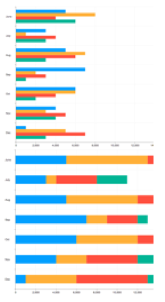
Security News
pnpm 10.0.0 Blocks Lifecycle Scripts by Default
pnpm 10 blocks lifecycle scripts by default to improve security, addressing supply chain attack risks but sparking debate over compatibility and workflow changes.
TOAST UI Chart is planning a v4 major update for 2021. First of all, You can see our Beta news here!

🍞📈 Spread your data on TOAST UI Chart. TOAST UI Chart is Beautiful Statistical Data Visualization library


TOAST UI Chart applies Google Analytics (GA) to collect statistics on the use of open source, in order to identify how widely TOAST UI Chart is used throughout the world. It also serves as important index to determine the future course of projects. location.hostname (e.g. > “ui.toast.com") is to be collected and the sole purpose is nothing but to measure statistics on the usage. To disable GA, use the following usageStatistics option when creating charts.
var options = {
...
usageStatistics: false
}
tui.chart.barChart(container, data, options);
Or, include tui-code-snippet(v1.5.0 or later) and then immediately write the options as follows:
tui.usageStatistics = false;
 Chrome Chrome |  Internet Explorer Internet Explorer |  Edge Edge |  Safari Safari |  Firefox Firefox |
|---|---|---|---|---|
| Yes | 8+ | Yes | Yes | Yes |
| IE8 | CHROME |
|---|---|
 |  |
No one likes legacy, but sometimes it matters.
We started TOAST UI Chart because we could not find a project supporting legacy browsers, maintained reliably, and free for commercial use.
The visuals of the charts in IE8 are exactly as it looks in Chrome.
The TOAST UI Chart guarantees an identical look for all browsers. Draws fast and requires no polyfill, ToastUI uses of the native browser formats, such as SVG and RVML.
The TOAST UI Chart will continue to support legacy browsers under the MIT license
With over 50 releases since June 2015 under MIT License, the TOAST UI Chart is the answer if you have the same requirements as us.
The TOAST UI Chart provides many types of charts to visualize the various forms of data.
| Bar Column | Line Area Radial | Bubble Scatter | Pie(General) Pie(Donut) |
|---|---|---|---|
 |  |  |  |
| Heatmap Treemap | Map | Boxplot | Bullet |
|---|---|---|---|
 |  |  |  |
The TOAST UI Chart covers complex data visualization.
| Column-Line | Pie-Donut | Line-Area | Line-Scatter |
|---|---|---|---|
 |  |  |  |
Visualize the data in different styles by customizing the details of the charts.
| Various expressions | Custom theme | Stack option | Diverging option | Group tooltip |
|---|---|---|---|---|
 |  |  |  |  |
Check out Example and wiki to discover more.
The TOAST UI products can be installed by using the package manager or downloading the source directly. However, we highly recommend using the package manager.
The TOAST UI products are registered in two package managers, npm and bower. Install by using the commands provided by each package manager. When using npm, be sure Node.js is installed in the environment.
$ npm install --save tui-chart # Latest version
$ npm install --save tui-chart@<version> # Specific version
$ bower install tui-chart # Latest version
$ bower install tui-chart#<tag> # Specific version
The TOAST UI Chart is available over a CDN.
<link rel="stylesheet" href="https://uicdn.toast.com/tui.chart/latest/tui-chart.min.css">
<script src="https://uicdn.toast.com/tui.chart/latest/tui-chart.min.js"></script>
The types of distribution files are classified into three types depending on whether or not they exist in the code of the dependency file.
tui-chart.js - This is not include dependency modules in the code.tui-chart-all.js - Includes all dependency modules, including 'babel-polyfill', in bundle file codetui-chart-polyfill.js - This includes only babel-polyfill in code.Within the download you'll find the following directories
tui.chart/
├─ latest
│ ├─ tui-chart.js
│ ├─ tui-chart.min.js
│ ├─ tui-chart-all.js
│ ├─ tui-chart-all.min.js
│ ├─ tui-chart-polyfill.js
│ ├─ tui-chart-polyfill.min.js
│ ├─ tui-chart.css
│ ├─ tui-chart.min.css
│ ├─ maps/
│ │ ├── (china | japan | singapore | south-korea | taiwan | thailand | use | world).js
├─ v3.0.1/
Add the container element where TOAST UI Chart will be created.
<div id="chart"></div>
The TOAST UI Chart can be used by creating an instance with the constructor function. To access the constructor function, import the module using one of the three following methods depending on your environment.
var chart = tui.chart; /* namespace */
var chart = require('tui-chart'); /* CommonJS in Node.js */
import chart from 'tui-chart'; /* ES6 in Node.js */
Factory function needs three parameters: container, data, options
var container = document.getElementById('chart-area');
var data = {
category: [...], series: [...]
};
var options = {
chart: {width: 700, height: 400}
};
chart.barChart(container, data, options);
Refer to details for additional informations.
The TOAST UI products are open-source. After fixing issues, create a pull request(PR). Run npm scripts and develop with the following process.
Fork develop branch into your personal repository.
Clone to local computer.
Install node modules.
Before starting development, check for any errors.
$ git clone https://github.com/{username}/tui.chart.git
$ cd tui.chart
$ npm install
$ npm run test
Let's start development! Run a server and see the code reflected. Add test cases and then make them green.
$ npm run serve
$ npm run serve:ie8 # Run on Internet Explorer 8
$ npm run test
Before creating a PR, test and check for any errors. If there are no errors, then commit and push!
For more information, please refer to the Contributing section.
$ npm run deploy
$ npm run test
See the older versions of API page on the releases page.
FAQs
TOAST UI Application: Chart
We found that tui-chart demonstrated a not healthy version release cadence and project activity because the last version was released a year ago. It has 1 open source maintainer collaborating on the project.
Did you know?

Socket for GitHub automatically highlights issues in each pull request and monitors the health of all your open source dependencies. Discover the contents of your packages and block harmful activity before you install or update your dependencies.

Security News
pnpm 10 blocks lifecycle scripts by default to improve security, addressing supply chain attack risks but sparking debate over compatibility and workflow changes.

Product
Socket now supports uv.lock files to ensure consistent, secure dependency resolution for Python projects and enhance supply chain security.

Research
Security News
Socket researchers have discovered multiple malicious npm packages targeting Solana private keys, abusing Gmail to exfiltrate the data and drain Solana wallets.